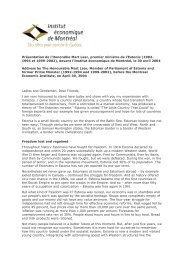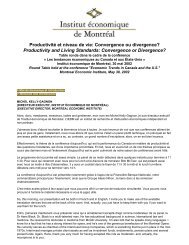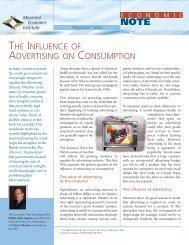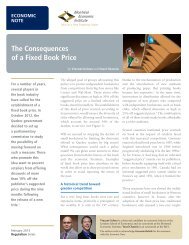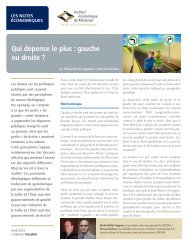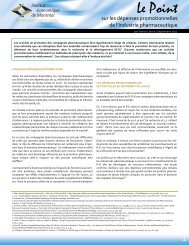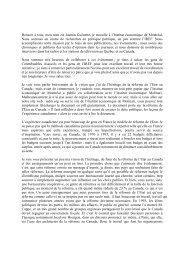Publication (PDF format) - Institut économique de Montréal
Publication (PDF format) - Institut économique de Montréal
Publication (PDF format) - Institut économique de Montréal
Create successful ePaper yourself
Turn your PDF publications into a flip-book with our unique Google optimized e-Paper software.
Why New International Taxes for Development Are InefficientChart 2 Important IFD Mechanisms and Agencies, Implemented or Proposed as of 2010*INITIATIVEPURPOSEHOW DOES IT WORK?REVENUESIS IT OFFICIALDEVELOPMENTASSISTANCE?NEW AGENCIESGAVI Alliance (2000)Public-private partnership forimmunisations.Pooled funds distributed, basedon proposals from poorer<strong>de</strong>veloping countries.About USD 300m. a year. USD3.7b. approved for 2000-15, asof 2009.Yes, but only for officialcontributions.The Global Fund (2002)NEW MECHANISMSPublic-private partnership tofight AIDS, TB and malaria.Pooled funds distributed, basedon proposals from poorer<strong>de</strong>veloping coountries.About USD 3.2b. a year. Total ofUSD 14b. raised by 2009.Yes, but only for officialcontributions.(a) New revenue raisingAir-ticket levy (2006)Fund a purchase facility(UNTAID) for AIDS, TB andmalaria treatments.13 countries apply a domestictax (2009). UNITAID funds arechanneled through existinginstitutions, esp. ClintonFoundation.USD 251m. a year.Yes, when funds collectedare paid to UNITAID or otherinternational agencies.Auctioning/sales of emissionpermits (2009)Currency Transaction Levy(b(b) Bonds (front-loading)International Finance Facility forImmunization (IFFIm, 2006)(c ) Voluntary contributionsGlobal Digital Solidarity fund(2003)(PRODUCT) RED (2006)Airline ticket voluntary solidaritycontribution(d) Guarantees (incentives)Advance Market Commitment(AMC, 2007)In<strong>de</strong>x-based weather insuranceProvi<strong>de</strong> funds for climatemitigation and adaptation.Increase the funds allocated tofinance <strong>de</strong>velopment.Fund GAVI campaigns.Promote an inclusivein<strong>format</strong>ion society.Provi<strong>de</strong> additional funding toGlobal Fund’s activities in sub-Saharan Africa.Provi<strong>de</strong> additional resources tofund UNITAID activities.Provi<strong>de</strong> incentive to <strong>de</strong>velopnew vaccines.Un<strong>de</strong>r EU regulations, EUAllowances (EUA) for carbondioxi<strong>de</strong> emissions are sold toemitters.Governments apply a tax onforeign exchange transactions.Bonds are sold in theinternational capital marketsagainst legally binding longtermODA commitments from 8donor countries.Public or private bodiesvoluntarily contribute 1% ofdigital procurement contracts.Product RED tra<strong>de</strong>mark licensedto global companies that pledgea share of profits from sales ofRED Products to Global Fundprograms.Individuals or corporations electto contribute to <strong>de</strong>velopementwhen booking flights.Donors commit to buy asuccesful vaccine from vaccinemakers at a negotiated pricewhich covers <strong>de</strong>velopment costs.Reduce the vulnerability of rural IFAD-WFP partnership provi<strong>de</strong>spoor to extreme weather events. farmers with weather-in<strong>de</strong>xedinsurance.Germany’s 2009 budgetallocates EUR 225m. in EUAsales to <strong>de</strong>velopment.Levying 0,005% on majorcurrencies would yield USD 33b.a year.USD 2.4b. raised by 2009; aim isto raise a total of USD 4b.Since 2003, more thanEUR 30m. allocated to300 grantees.USD 134.5m. tranfered to GlobalFund to date.USD 2 per ticket contributionmight raise up to USD 960m.a year.USD 1.5b. pledged by 5donors and Bill & MelindaGates Foundation for AMC forpneumococcal disease.Weather insurance schemesalready piloted in Ethiopia,Malawi, Nicaragua, Hondurasand India.Yes, when proceeds are spenton <strong>de</strong>velopment.Yes, when funds collectedare spent on <strong>de</strong>velopmentassistance.Yes, for governement paymentsto meet bond interest andprincipal.Yes, but only for officialcontributions.No, only when private fundsare involved.No, only when private funds areinvolved.Yes, but only when donorgovernments pay for vaccines.Yes, but only for officialcontributions to insurancepremiums.* Italics represent proposed schemes as of 2010. As suggested in the text, many projects have changed since. Source: Sandor et al. (2009), p. 4.Montreal Economic <strong>Institut</strong>e 11



